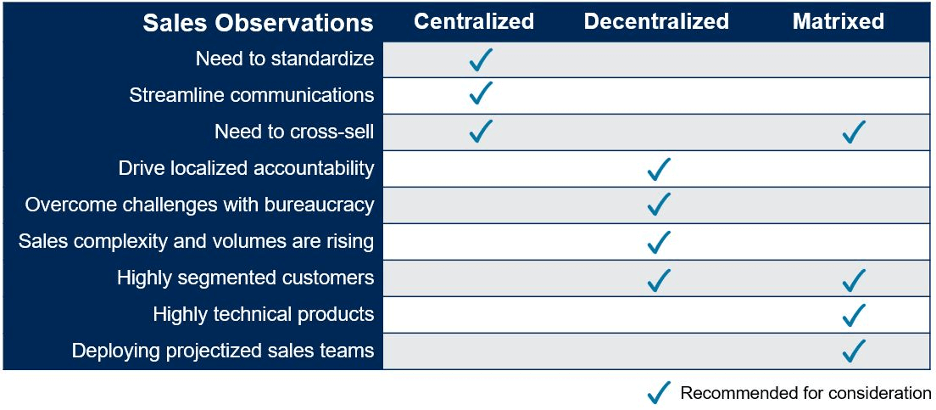Organizational redesign is a daunting, nebulous, and risky task for chief sales officers (CSOs). It can make or break the path forward for a commercial organization. Instead of redesign, CSO’s often focus on small changes around the edges to overcome challenges, a do not rock the boat mentality. But this incremental and one-off approach often prolongs core issues and limits the size of commercial successes. So how can CSOs dive into the water of organizational redesign the right way?
When approached carefully, reorganizing a sales organization can unlock sustainable growth and success. This all starts with defining the five core components of a redesign that emphasize efficiency and effectiveness; strategic priorities, segmentation and tiering, orchestration and execution, workforce planning, and governance and oversight.
There is no best or universal sales organizational structure, but the old business adage that structure should follow strategy certainly applies to sales organizations.
When organizational design changes are required, CSOs must identify which structure aligns best with their goals while recognizing the tradeoffs that are likely to occur. Here are three steps to follow to identify and select the best design to match your needs.
Step 1. Reaffirm the Sales Strategy
CSOs can start by establishing or validating the overarching strategy for the sales organization, which should be aligned with the overall corporate objectives and cascade to sales objectives and target setting.
An example of a strong sales strategy statement is: “By developing customer relationships within new verticals and cross selling our full product suite into our existing customer base, we look to grow revenue by 20% annually over the next three years.”
Ensure the sales strategy is also aligned to other core functions, like marketing, to achieve a unified commercial strategy. When all elements harmonize to support the strategic goals, tracking progress and finding success become more objective. In fact, recent Gartner data suggests sales organizations that align cross-functional KPIs are nearly 3 times more likely to exceed new customer acquisition targets.
Step 2. Analyze the Contributions to Sales Performance
Sales performance can become an intimidating web of information given the variety of metrics, markets, and external factors that influence output. But in reality, a simplistic approach starting with two fundamental questions should drive this analysis:
- Where are our sellers successful?
- What are our sellers focused on?
Sales analytics such as bookings and revenue are excellent ways to examine seller performance. CSOs can lean on new technology to more closely analyze losses and better forecast pipeline trends. This also enables them to glean insights about organizational design alignment, helping complete the picture of where sellers stand on efficiency and effectiveness.
CSO’s should use the same data driven approach to examine seller focus. For example, looking at key pipeline indicators – such as number of opportunities, total opportunities or dollars by product, segment or geography – reveals where sellers are spending their time.
If the sales strategy is to penetrate new verticals, CSOs should analyze sellers’ performance and pipelines by vertical. Revenue indicates the sellers’ ability to win deals, while pipeline data reveals more about the sellers’ level of attention and activity.
Step 3. Evaluate the Different Sales Organizational Structures
Before diving into a solution, CSO’s should examine the three most common sales organizational structures:
- Centralized: characterized by a few leaders at the top of the hierarchy holding the organization’s decision rights
- Decentralized: empower a lower level of management to own sales decisions, including those regarding account management, price/deal exceptions and sales priorities
- Matrixed: decisions and accountability are shared both vertically and horizontally
Each structure has a variety of advantages and disadvantages, so it’s imperative to evaluate each one based on sales complexity, go to market strategy, sales force, customer profile, and product mix.
To do this, CSO’s should look for both qualitative and quantitative evidence to inform their decision. For example, sales volume, product share, and customer segment numbers are key quantitative inputs to understand the best design. But it is also important to get additional feedback from managers, sellers, and customers to surface insights and objectives about key attributes like communication, standardization of information, and accountability.
CSO’s should use a checklist (Figure 1) to understand their sales objectives and needs and compare different approaches.

Source: Gartner (December 2022)
Rome wasn’t built in a day, so CSOs need to be thoughtful and patient throughout the sales organization redesign. Knowing when to make changes is just as important as knowing what changes to make, so following the above advice will get you there.
Join Mike Katz, Dave Egloff and their colleagues to learn more about sales design and deployment at the 2023 CSO & Sales Leader Conference, May 16-17, in Las Vegas.




